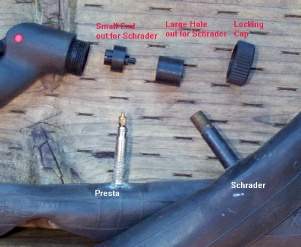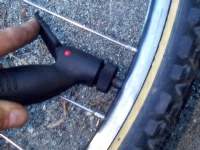| Bicycling Life |
About Our Site
Issues & Editorials
Solutions for Little
Problems,
Adjustments, and Repairs.
Using Bikes in Everyday
Life
Commuting & Errands
Cycling for Fun &
Health
Street Smarts for Bicyclists
Safety Issues
Advancing Cycling Issues
Getting Involved
Position Papers
Research and
Source Documents
|
| |
|
  How to Convert A Pump How to Convert A Pump
|
Many folks never think ahead enough to bring a pump and patch kit. You, however,
are ahead of the game because you read the Bicycling Life How-To pages, and know exactly
what to do.
But if you are new to cycling, or more specifically new to hand pumps you may go for
months with no problem and then get a flat 15 miles from nowhere.
Being well prepared you patch the tire and start to pump it up, only to find that
The pump will not fit your valve stem.!!
RELAX! Almost all pumps
are convertable between the only two types of valve stems used on bikes. You may
have to convert yours before you use it depending on how it came from the manufacturer.
There are two types of valve stems. Presta, and Schrader. Your car uses Schrader,
many bikes do too.
| The silver colored one in the picture at right is Presta, the
other, like your car tire, is Schrader. On the business end of your hand pump you will
find a locking cap that screws off (far right).
Just inside of that you will find a rubber cylinder. One end of this cylinder has
a large hole, the other a small one. |

Click the picture for and enlarged view
|
| For Schrader valves put the Large hole pointing out (towards the locking
cap) when you install it in the pump head. Just under the rubber cylinder is a
valve-stem-depressor (nearest pump head in photo). It has a pointy end, and an open
end. For Schrader valves, install this in the pump head with the small pointy end
pointing out. It's job is to press down on that little stud in the center of the
valve so air can get in.
 Finally, we should mention that most pumps come with
locking levers. These cause the rubber cylinder to clamp down on your valve stem and
give a good air-tight seal. They don't work all the same way. Finally, we should mention that most pumps come with
locking levers. These cause the rubber cylinder to clamp down on your valve stem and
give a good air-tight seal. They don't work all the same way.
Look into the business end of your pump as you work the lever. You should see the hole
in the rubber cylinder get smaller when the lever is in one position. That is the
locked state, you have to move the lever to the un-locked position to put it on the valve
stem, then lock it while you pump.
If you can't see any difference betweeen locked and unlocked, it means your locking cap
is not tight enough. |
|
  |
|
By
|
